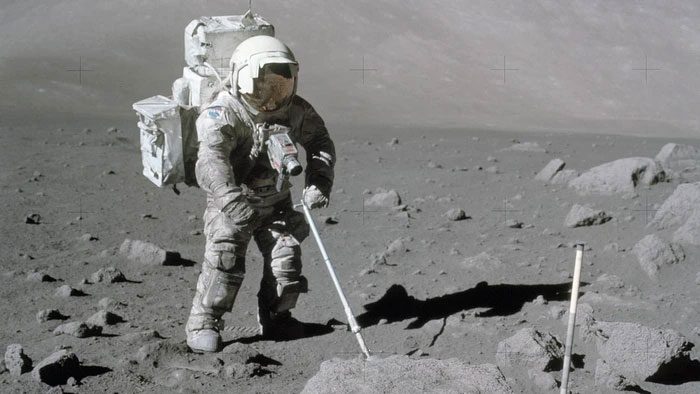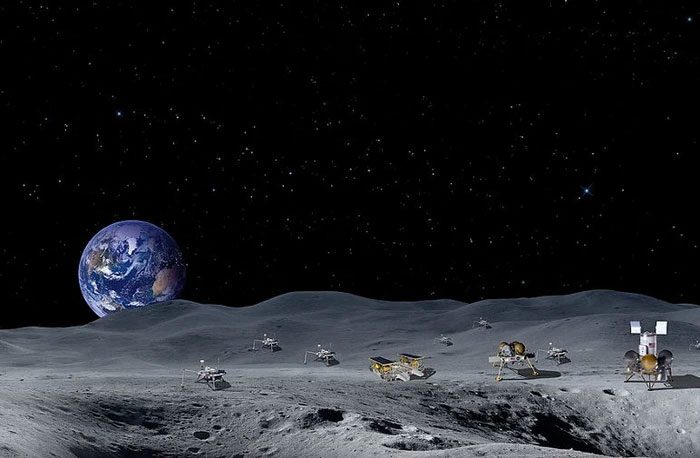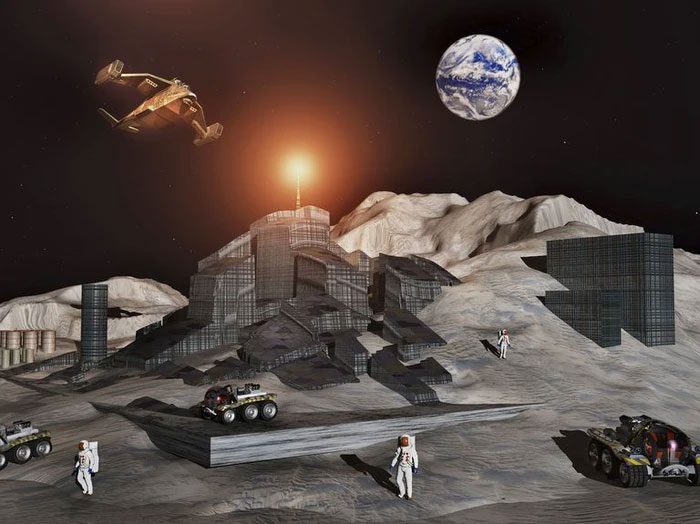The Crisis from Earth…
In the article “The Feasibility of Mining Helium-3 on the Moon”, scholars from Delft University of Technology (Netherlands) noted that with fossil fuels depleting and global energy demand rising, the need for alternative energy sources is clear. As materials on Earth become scarcer, many have turned their attention to mining on the Moon…
When astronaut Harrison Schmitt first set foot on the Moon on December 12, 1972, from Apollo 17, oil was trading at $3.60 per barrel, and oversized cars were still guzzling premium unleaded fuel by the barrel. “The energy crisis” was something the world had yet to encounter.

Astronaut Harrison Schmitt stepping onto the Moon on December 12, 1972. (Photo: NASA).
37 years later, in 2009, no one had walked on the Moon for years, global energy consumption had nearly doubled, oil reserves were rapidly depleting, and humanity was facing one of the harshest challenges in history: Energy Shortage.
As a well-trained geologist, former NASA astronaut Schmitt believes he has a solution, and that solution is called “Helium-3.” Harrison Schmitt argues that fusion could help “meet the energy demand projected to increase eightfold or more by 2050.“
| * Helium-3 is an isotope of Helium with two protons and one neutron. |
In his 2006 book – “Return to the Moon” – Harrison Schmitt (the geologist for the Apollo program) presents a compelling case for mining Helium-3 on our natural satellite as a viable fuel for “second-generation” fusion power plants.
The idea of extracting a clean and efficient energy source from the Moon has sparked the interest of both science fiction and reality in recent decades. Unlike Earth, which is protected by its magnetic field, the Moon has been bombarded by solar winds carrying large amounts of Helium-3.
This isotope is believed to provide safer nuclear energy in fusion reactors, as it is non-radioactive and will not produce hazardous waste, according to the European Space Agency (ESA).
Specifically, for decades, scientists have been captivated by Helium-3 and its potential fuel source for nuclear fusion. Nuclear fusion occurs naturally when two light atoms merge into a heavier atom under extreme pressure and temperature. These reactions take place within stars, but humanity has yet to create a fusion reactor with enough energy to initiate this process.

The Moon has been bombarded by solar winds carrying large amounts of Helium-3. (Illustration: NASA).
Helium-3 is an extremely rare and expensive material on Earth. According to the European Space Agency, Helium-3 is particularly promising because it produces significantly less radioactive and nuclear waste compared to other elements. The current nuclear fission process, used in nuclear power plants, releases not only energy but also radiation, and nuclear fuel must be reprocessed into uranium, plutonium, and other waste.
This process raises serious safety concerns, prompting scientists to seek ways to generate nuclear energy from nuclear fusion instead of fission. In the fusion process, no radioactive waste is generated, potentially creating a safer and more efficient fuel source.
It is estimated that around 25 tons of Helium-3 (equivalent to a fully loaded cargo bay of a Space Shuttle) could supply energy to the United States for one year at current consumption rates. This means Helium-3 has a potential economic value of $3 billion per ton, Discovery.com reports.
The Russian news agency TASS stated that in 2018, the head of the Indian Space Research Organization, Dr. Kailasavadivoo Sivan, mentioned that theoretically, the amount of Helium-3 found on the Moon could keep the world energy sector running for at least 250 years.
The Race to the Moon
Helium-3 on the Moon is often seen as the main reason for a return to lunar exploration.
Asia Times suggests that there is a “secret mining war” occurring in space over Helium-3 among China, the United States, and possibly Russia regarding potential resources on the Moon.
At different times, plans to extract Helium-3 from lunar soil have existed in Russia, the United States, and India. Currently, Helium-3 is not mined on Earth. It is a decay product of Tritium that is produced artificially, TASS reports.
The journey to the Moon for this clean nuclear material has been further propelled after Chinese scientists announced in 2022 the discovery of rare lunar crystals, promising abundant and endless energy for Earth.
These crystals were found in lunar basalt samples collected from the Moon in 2020, making China the third country to discover a new lunar mineral after the United States and the Soviet Union.
The Beijing Uranium Geological Research Institute in China named the phosphate mineral Changesite-(Y), after the Moon goddess in Chinese mythology, Chang’e. This crystal is transparent and nearly as thin as a human hair. It formed in an area of the Moon that experienced volcanic activity about 1.2 billion years ago.
One of the main components found in this crystal is Helium-3. This element is extremely rare on Earth but is believed to be relatively abundant on the Moon.
That’s why many private companies and countries with space agencies have ignited a race to mine the Moon for Helium-3.
It is reported that China’s next lunar mission is set to be Chang’e 6 in 2024, which will attempt to collect the first samples from the far side of the Moon – the side that never faces Earth.

With the successful launch of the SLS super rocket, NASA is gradually finalizing its precursor missions to send humans to the Moon in 2024. (Photo: NASA)
Meanwhile, NASA is gradually implementing its Artemis program to return humans to the Moon. It is expected that in 2024, the U.S. will send two astronauts to land on the Moon again.
The European Space Agency (ESA) has also considered using the Moon to support missions further into the Solar System.
In addition to traditional spacefaring nations, India has previously expressed its interest in mining the lunar surface.
Private enterprises are also interested in utilizing resources from the Moon – although potentially by extracting water rather than Helium-3. Shackleton Energy Company (U.S.) plans to provide propulsion fuel for missions throughout the Solar System using water from the Moon.
Some teams competing for the Google Lunar X-Prize also view lunar mining as the ultimate goal for their landers.
Is Success Feasible?
Delft University of Technology (Netherlands) estimates that to meet 10% of global energy demand by 2040, 200 tons of Helium-3 would be required each year.
To achieve this, the lunar material (regolith) extraction rate would need to be 630 tons per second. This would require between 1,700 to 2,000 Helium-3 mining vehicles if using the Mark III mining machine from the University of Wisconsin, U.S.
The feasibility has been addressed in three aspects.
- Technically, the mission is extremely challenging and complex. However, most of the necessary technologies exist or could be developed within a reasonable timeframe.
- From a political and legal perspective, current international treaties provide little framework for lunar mining operations.
- Financially, missions would only generate net profit in the best-case scenarios and only for medium to large scale operations, requiring significant initial investment.
In order to utilize Helium-3 on the Moon, further research should focus on the extraction processes and the costs of fusion plants, as their impacts far exceed all other mission factors.

The concentration of Helium-3 is estimated to be around 20 to 30 parts per billion in lunar soil. (Illustration: Internet).
Clearly, humanity can extract many things from the Moon as they have done in human missions and robotic exploration. However, these missions are not without their challenges due to the vast distance between Earth and the Moon.
We have examples of similar challenges right here on Earth: There are approximately 45,000 to 1.5 million tons of gold in the Earth’s oceans. However, due to the commonality of gold, the cost of extracting it is much higher than the actual market price of gold.
Similarly, the cost of transporting Helium-3 from the Moon would be substantial due to the reasons of distance and low concentration. The concentration of Helium-3 is believed to be around 20 to 30 parts per billion in lunar soil.
This means that a large amount of the lunar surface would need to be harvested and processed to extract a quantity of Helium-3 worth transporting back to Earth.
Furthermore, according to Aleksandr Bloshenko, the executive director of research and science programs at the Russian State Space Corporation Roscosmos, the fusion of Helium-3 atoms requires temperatures of up to 1 billion degrees Celsius. He does not rule out the possibility that one day in the future, humanity will come up with a solution for nuclear fusion at such temperatures, TASS reports.
In the future, will journeys to the Moon and the regular presence of humans along with lunar mining vehicles help us escape a major energy crisis? To answer this question will take a considerable amount of time.


















































